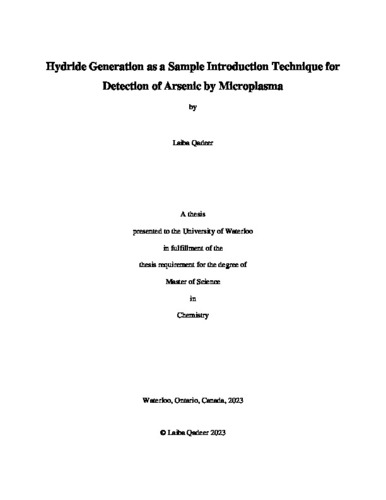| dc.description.abstract | Microplasma can be used as a portable analytical instrument for elemental analysis of samples due to their small size, low power consumption, low carrier gas consumption, and low cost. This is specifically important for areas where contamination of water by arsenic is prevalent (e.g., because arsenic is indigenous to the soil). Due to the volatility of arsenic and its organic compounds, it is only chemical vapor generation (CVG) that can be used to introduce the sample into the microplasma. In this project, equipment for hydride generation (a type of CVG) was designed and used to test this sample introduction technique for microplasma. It was found that response of microplasma towards water vapors and hydrogen released from the hydride generation reaction was different when it was operated in each of three different carrier gases, namely helium, argon, and mixture of argon with 1000 ppm hydrogen. Similarly, the best observation position for arsenic over the microplasma tube was also different for helium microplasma and argon microplasma (0.84 cm and 1.34 cm away from the front electrode where carrier gas and analyte are introduced, respectively). Arsenic signals were also found to be more intense in helium microplasma, as compared to that in argon microplasma and argon – 1000 ppm hydrogen microplasma. Afterwards, the arsenic peaks at 197.3 nm and 228.8 nm were used to estimate the detection limit for arsenic in helium microplasma and argon microplasma, respectively. The detection limit for arsenic in helium and argon microplasma were estimated to be 31 ppb and 40 ppb, respectively. Although this project proved the feasibility of microplasma for detecting arsenic in liquid samples, it was concluded that more research is needed in this field to improve the reproducibility in the measurement of emission signal and the detection limit for arsenic, by making changes in the equipment and the design of gas-liquid separator. | en |

